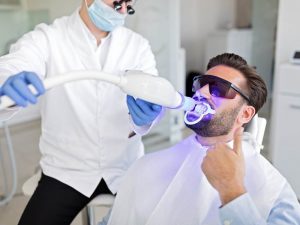Zoom is a popular professional teeth whitening treatment that can be completed in-office by a licensed dentist.
This chairside treatment can whiten teeth up to eight shades after one or two sessions, making it an extremely sought-after bleaching option.
However, like with any other type of dental procedure, there are advantages and drawbacks to Zoom teeth whitening which you should be aware of before undergoing the treatment.
On this page, we explain the pros and cons of Zoom teeth whitening and we will share our research information about it. Then you can decide if Zoom is right for you.
What Is Zoom Teeth Whitening?
Zoom teeth whitening defines a dental procedure that makes your teeth whiter and brighter.
Teeth are more resistant to this kind of treatment than the skin on your face or other parts of your body (which means less pain).
Your dentist will apply special seals and abates to protect against damage during the process so you don’t have any discomfort whatsoever.
Once it’s completed, you’ll receive an oral report documenting your teeth’s whiteness level.

The Pros Of Zoom Teeth Whitening
Zoom teeth whitening is a popular and effective method of teeth whitening. Some of the advantages of Zoom teeth whitening include:
1.Quick and Convenient
Zoom teeth whitening is a speedy process, often taking just about an hour.
It’s perfect for those of us with busy schedules who want a brighter smile without spending too much time in the dentist’s chair.
2.Immediate Results
One of the coolest things about Zoom is that you can see the results right away. It’s like a magic wand for your teeth!
As soon as the treatment is done, you’ll notice your teeth are several shades whiter.
3.Reduced Sensitivity
Unlike some other teeth whitening methods, Zoom is designed to minimize sensitivity. This means you can enjoy a dazzling smile without the discomfort that can come with it.
4.Customized Treatment
The Zoom process is tailored to your specific needs. The dentist considers factors like your current tooth shade, oral health, and your desired level of whiteness. It’s a personalized experience just for you.
5.Long-lasting Results
Zoom doesn’t just give you a temporary fix. With proper care, the results can last for a long time. Of course, good oral hygiene and avoiding excessive staining foods and drinks help maintain that bright smile.
6.Safe and Reliable
Zoom teeth whitening is a safe and reliable method approved by dental professionals. You can trust that you’re in good hands and that the process won’t compromise the health of your teeth.
The Zoom treatment supplies a professional-grade Crest 3D White Kit (combined Whitestrips) to maintain a bright appearance after the procedure.
7.Stain Removal
It doesn’t just whiten, it’s also excellent at removing stubborn stains.
Whether it’s coffee, tea, or red wine, it tackles those discolorations, leaving your teeth looking fresh and clean.
8.Boosts Confidence
A brighter smile often translates to increased confidence. Knowing that your teeth look their best can make you feel more self-assured in both personal and professional situations.
Whitening your teeth can give you a brighter, more vibrant smile that lasts up to a year with proper care.
It is a very affordable tooth whitening option, and there is less risk of gum irritation and enamel damage than with some other methods.
9.Minimal Upsetto Daily Life
Since Zoom is a quick process, you don’t have to rearrange your entire schedule. It’s a minor interruption that leads to major improvements in your smile.
10. In-office Professional Supervision
Unlike at-home kits, Zoom is performed in a dental office, ensuring professional supervision.
The dentist monitors the process, making adjustments as needed, and ensuring the best possible outcome for your teeth.
Read Also : Pros And Cons Of Osteostrong
The Cons Of Zoom Teeth Whitening
Although Zoom teeth whitening is a very safe and effective procedure, it should be done by someone who’s experienced it before.
There are more cons to this type of bleaching than pros so we’ve pared down these potential risks into 10 groups:
Let’s take a closer look at some of the cons associated with Zoom teeth whitening.
1. Sensitivity Surge
One major drawback of Zoom teeth whitening is that it can lead to a temporary increase in tooth sensitivity.
After the treatment, some people experience heightened sensitivity to hot or cold foods and beverages.
2. Gum Irritation
Zoom whitening involves applying a peroxide gel to the teeth, and this can sometimes irritate the gums.
It might result in redness or discomfort during and after the procedure.
3. Temporary Whitening
The whitening effects of Zoom are not permanent. Over time, teeth may gradually revert to their original shade, especially if habits like smoking or consuming staining foods and drinks persist.
4. Cost Concerns
Zoom is a dental whitening treatment that uses a high-intensity lamp to accelerate the bleaching process.
The treatment is expensive, typically costing between $500 and $1,500 per session.
5. Time Constraints and Maintenance Challenges
Zoom teeth whitening sessions typically take about an hour, which might be inconvenient for those with busy schedules.
Finding a suitable time for the procedure can be a challenge.
However, maintaining the results of teeth whitening may require additional touch-up treatments, adding to the overall cost and time investment associated with the procedure.
6. Pre-existing Dental Issues
People who have cavities or gum disease might not be able to get Zoom whitening. It might be necessary to fix these problems before getting the treatment.
7.No Customization
This treatment cannot be customized for each person. This lack of customization may cause discomfort for some people or lead to less-than-ideal results.
8. Inability to Address Intrinsic Stains
Intrinsic stains are discolorations within the tooth. Zoom whitening may not work well on these stains. This means the procedure might not be effective for all types of stains.
9. Temporary White Spots
After getting it, some people might see white spots on their teeth.
These spots usually go away over time, but they might worry people who want their teeth to look completely natural.
10. Reliance on Professional Setting
It must be performed in a dental office, limiting the convenience for those who prefer at-home whitening solutions.
Must Read : Sugar And Psoriasis : How Sugar Impacts Psoriasis
How Does Zoom Teeth Whitening Work?
Zoom teeth whitening is a particularly effective method that uses materials to help your enamel become whiter. First, the dentist will cover your lips and gums to protect them.
Then, a special gel containing hydrogen peroxide is applied to your teeth. This gel works by breaking down stains on the enamel and dentin layers of your teeth.
Once the gel is applied, a Zoom light is directed at your teeth, which helps activate the whitening process. The light accelerates the gel’s action, allowing it to penetrate and lift away discoloration.
Throughout the procedure, the gel is reapplied at intervals, and the light is used to enhance its effects. The entire process usually takes about 45 minutes to an hour.
Afterward, your teeth will be noticeably whiter, and you’ll leave the dentist’s office with a brighter, more radiant smile.
It’s a straightforward and safe way to enhance your teeth’s appearance without a lengthy or complicated process.
Zoom Teeth Whitening Cost
It can cost anywhere from $500 to $1500 for a Zoom Teeth Whitening treatment, depending on the severity of the whitening needs and the type of dental professional performing the treatment.
Most dentists will offer a discount for multiple treatments, so it is important to schedule an appointment early to get the best deal.
Once you arrive at the dental office, the technician will take a look at your teeth and determine the level of whitening needed.
After that, the procedure will begin.
Frequently Asked Questions (FAQs)
How Long Does Zoom Teeth Whitening Last ?
Zoom teeth whitening can last for a significant amount of time, but the duration varies from person to person.
On average, the results of Zoom teeth whitening can last anywhere from 12 months to 24 months.
Is It Safe To Use Zoom Teeth Whitening?
It is 100% natural and it does not involve the use of any abrasive or harmful chemicals.
The procedure has been proven to be safe in patients with braces, veneers, or implants.





